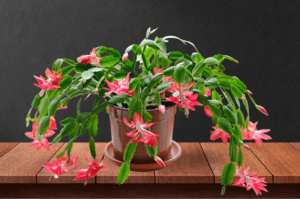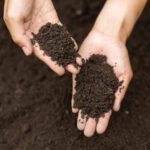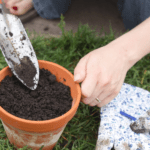Well-drained soil is the lifeblood of your plants. It provides the perfect balance of water and air, allowing roots to breathe and absorb essential nutrients.
When your soil is well-drained, excess water can easily flow away, preventing root rot and other water-related issues.
This creates an environment where plants can establish strong root systems, withstand droughts, and thrive in various conditions.
Growing your plants in well-drained soil will give you the feeling of satisfaction that comes with knowing your plants are thriving in suitable soil.
What is Well-drained Soil?

Well-drained soil refers to soil that has good drainage, allows for proper water movement, and prevents waterlogging.
This is essential for the health and growth of plants as it ensures that their roots receive adequate oxygen and nutrients.
Soil permeability is a key factor in determining whether the soil is well-drained or not. It refers to the ease with which water moves through the soil.
When the soil has good permeability, water can flow through it freely, preventing water accumulation around plant roots.
The composition of well-drained soil typically includes a mixture of sand, silt, and clay, creating a balanced environment for plant growth.
Benefits of Well-drained Soil
The advantages of soil with excellent drainage include healthier plants, improved root development, and increased nutrient absorption.
- Prevents waterlogged roots: Well-draining soil allows excess water to flow away, preventing roots from sitting in water and becoming waterlogged, which can lead to root rot and other diseases.
- Enhances root growth: With proper drainage, roots can penetrate deeper into the soil, accessing more water and nutrients, resulting in stronger and healthier plants.
- Increases nutrient availability: Well-drained soil promotes the breakdown of organic matter and compost, releasing essential nutrients that plants need for growth.
When water can freely move through the soil, oxygen is available to plant roots which promotes optimal growth.
How to Test for Drainage

To determine if your garden has proper drainage, try performing a simple test using a small hole and water.
Dig a hole about 6 inches deep and wide in the area you want to test. Fill the hole with water and wait for it to drain completely.
If the water drains within 24 hours, congratulations! You have well-draining soil.
This means that excess water will not accumulate and cause waterlogged soil or water saturation, which can be detrimental to plant growth.
However, if the water takes longer than 24 hours to drain or remains in the hole, you may have poorly drained soil.
In this case, you will need to improve drainage by incorporating organic matter or creating raised beds to prevent waterlogging.
Ways to Improve Drainage
Adding organic material to your soil can significantly enhance its permeability and promote better drainage.
Here are four ways to improve drainage in your soil:
- Mix in shredded leaves: Adding shredded leaves to your soil helps increase its organic matter content, improving drainage. The decomposed material from the leaves helps create air pockets within the soil, allowing excess water to drain more efficiently.
- Break up clay soil: Breaking up the clay soil and incorporating organic matter can help improve its drainage capabilities. This can be done by tilling the soil and adding compost or other organic materials.
- Install drainage systems: In areas where drainage is a persistent issue, installing drainage systems like French drains or dry wells can help redirect excess water away from the soil.
- Raise garden beds: Creating raised garden beds can help improve drainage, especially in areas with heavy soil. By elevating the soil, you provide better aeration and prevent water from pooling around plant roots.
How to Fix Poor Drainage
Soggy soil can be a headache, but there are solutions.
First, check if your soil is compacted. Compacted soil prevents water from draining properly, so it’s important to aerate it by loosening it up with a garden fork or tiller.
You may also create raised beds or mounds, which improve drainage by elevating the soil.
If you’re dealing with heavy clay soil, consider adding organic matter like compost to improve its structure.
Additionally, using a well-draining container soil mix can prevent water from getting trapped in pots.
Lastly, consider planting drought-tolerant or drought-resistant plants that can handle excess moisture.
Conclusion
Understanding the concept and benefits of well-drained soil can help you create a healthy environment for your plants to thrive.
Remember, “A stitch in time saves nine.” So, regularly testing and improving drainage will prevent costly and time-consuming problems in the future.
Take action now, and enjoy the fruitful results of a well-drained garden.
FAQs
Can well-drained soil help prevent root rot in plants?
Yes, well-drained soil can help prevent root rot in plants. It allows excess water to drain away, reducing the risk of waterlogged conditions that promote the growth of root-rotting fungi.
Does well-drained soil help reduce the risk of soil erosion?
Well-drained soil can indeed help reduce the risk of soil erosion. It allows water to infiltrate the soil quickly, preventing runoff and the loss of valuable topsoil. This promotes healthier plant growth and enhances the overall stability of the soil.
Can well-drained soil improve the overall health and growth of plants?
Well-drained soil is crucial for the overall health and growth of plants. It allows roots to access oxygen, nutrients, and water more easily, promoting efficient nutrient uptake and preventing root rot or suffocation.
What are the consequences of planting in soil with poor drainage?
Planting in soil with poor drainage can lead to waterlogged roots, suffocating plants, and root rot. Nutrient uptake becomes limited, affecting growth and health.







